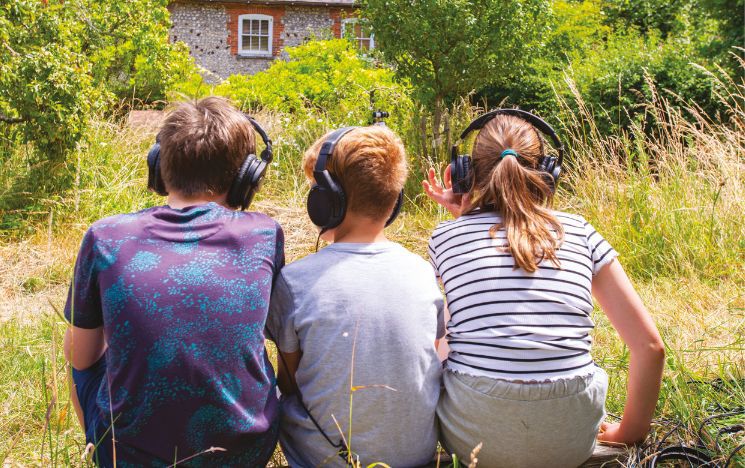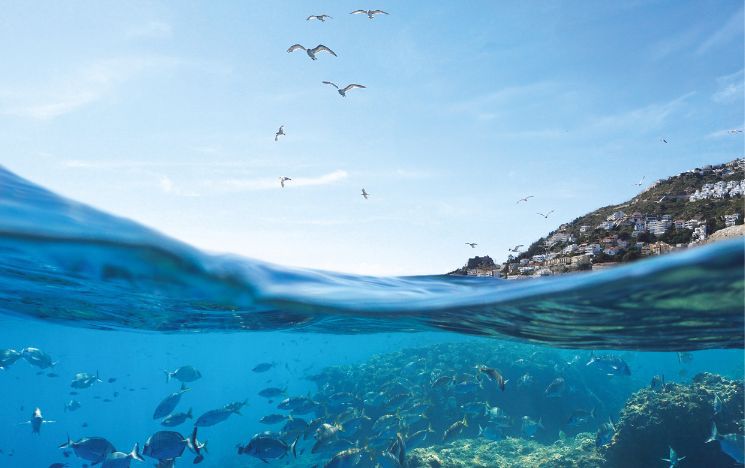Soundscapes
Doctors have listened to the health of our bodily systems for millennia. Now, explains Professor Alice Eldridge, we are making digital stethoscopes to listen to the health of our ecosystems.
All eyes are on climate change, but we are also entering the sixth great extinction. The positive news is that there are an increasing number of initiatives regionally, nationally and globally to support biodiversity recovery. But how do we know whether these interventions are working? And how can we monitor changes in our forests, soil systems, reefs, rivers and ponds at scale? Working with colleagues in the Sussex Digital Humanities Lab, Sussex AI and the Sussex Sustainability Research Programme, we are one of a growing number of groups globally that is learning to listen to ecosystems.
Across the tree of life, species communicate using sound in order to stay alive: finding mates, defending territory, warning of predators, calling for food, etc. The emerging ecological science of ecoacoustics studies the whole acoustic environment – or soundscape – to understand the ecological role of sound.
One strand of our research is focused on tools to analyse vast, complex, multispecies symphonies of wind, songs, stridulations and traffic.” PROFESSOR ALICE ELDRIDGE
Co-Director of Sussex Digital Humanities Lab
The soundscape is a highly dynamic pattern that emerges from the interaction of the sounds of biological, geophysical and anthropogenic processes: insects thrumming, birds calling, trees rustling and motors throbbing. These sounds combine to create soundscapes that are unique in time and space; think of the differences between sounds during morning rush hour and an evening on a beach. Unique acoustic signatures occur not only in human habitats but in natural ecosystems everywhere, below water and underground, including ponds, reefs and even soil ecosystems.
We now recognise that sound is a key ecological resource – just like food, water and space – which means it is also a source of information about the interactions that shape a given ecosystem and its status. In evolutionary terms, if members of a species can’t hear each other, they can’t mate, so there is pressure to occupy a unique acoustic niche. According to this line of reasoning, greater biodiversity will lead to greater acoustic diversity in the emergent soundscape.
The equipment to record is now robust and affordable. Collecting soundscape data – even of kilometres square over weeks, months and years – is relatively simple. Analysing it and understanding it is harder. One strand of our research is focused on tools to analyse these vast, complex, multispecies symphonies of wind, songs, stridulations and traffic. How best to do this and exactly what aspect of ecosystem health it describes remains an open question.
Our current research in analysis follows two distinct approaches. In one, we are creating new artificial intelligence models to learn ways to describe the differences in soundscapes between degraded and healthy ecosystems. Under a more speculative approach, we collaborate with colleagues in neuroscience to explore whether the dynamics of soundscapes might tell us more about ecological status than simply the diversity of sounds.
How can we tackle the 6th great extinction?
- Video transcript
Professor Alice Eldridge: We are entering the sixth great extinction.
[Birds flying and chirping noise as Professor Alice Eldridge stands before a projection of a large field with birds migrating]
Professor Alice Eldridge: We need to know what is happening in our forests, our farmland, our oceans and our soil ecosystems.
[MUSIC: Gentle instrumental]
[ON SCREEN TEXT: ‘Professor Alice Eldridge Co-Director of Sussex Digital Humanities Lab]
Professor Alice Eldridge: Our work in eco-acoustics -
[Camera shutter noise with photos of Professor Alice Eldridge in a forest with headphones around her neck]
[High-pitched frequency with slow motion video footage of a bee flying towards a flower]
Professor Alice Eldridge: Aims to develop tools to listen in to the soundscape that emerges from an ecosystem as a way to understand its health.
[Muted noise with video footage of Professor Alice Eldridge giving a lecture]
Professor Alice Eldridge: Listening to these soundscapes, we find helps people connect with nature and remember that they are a part of, not apart from the rest of the living world.
[Heartbeat noise over video footage of a rainforest river]
[MUSIC: Upbeat instrumental]
Professor Alice Eldridge: Our research centre brings together experts from arts and humanities, computing and social sciences, remixing those disciplines to solve the challenges that we're facing. The next generation of tools for planetary care will be co-created with scientific and traditional ecological knowledges. We hope to create a world where people and planet thrive as one.
[END CARD: University of Sussex logo ‘Impossible until it’s done ’ with URL sussex.ac/impossible]
Whilst we are developing new technologies for eavesdropping on ecosystems, for some communities, listening to ecosystems is nothing new at all. When working in Indonesia with a local reef restoration project to explore the potential for digital listening, I asked the local marine biologist whether he thought we could hear the difference between healthy and degraded reefs. “Oh yes,” he said, “when we night fish, we put the end of the oar on our ear. When we hear what sounds like rain, we know we are on the reef where the fish are.” These resonances between traditional ecological knowledge and technoscientific approaches are encouraging. If we can co-create affordable tools that integrate the strengths of each way of knowing, there are possibilities to empower community conservation efforts for the benefit of people and planet.
Sound is a key ecological resource – just like food, water and space – which means it is also a source of information about the interactions that shape a given ecosystem and its status.” PROFESSOR ALICE ELDRIDGE
Co-Director of Sussex Digital Humanities Lab

For urban societies, digital soundscapes can also help people to reconnect to wider nature with great benefit. Our work explores soundscape listening in education, cultural events and online experiments. In an ongoing project with flagship nature recovery project, Knepp Wilding, anyone anywhere is invited to tune in online to Wilding Radio to hear a livestream of the soundscapes above and below water from the developing wetland area created by beavers. It’s popular, reaching audiences of 15,000 in 2023 alone. Emerging research shows that simply listening to natural soundscapes is a powerful way to reconnect with nature that also helps to reduce stress and promote pro-environmental behaviours.
Our daily soundscape is a site of interaction between the elements, life and human-created technologies. It provides a rich space to better understand interrelations between the environment, society, culture and technology. We are developing an approach to studying the soundscape in a transdisciplinary way, because we believe that by developing technologies to listen to the rest of the living world and engaging people in that process, we can take a small step to tackle both the consequences and causes of current ecological crises, and help create a world where people and planet thrive as one.
